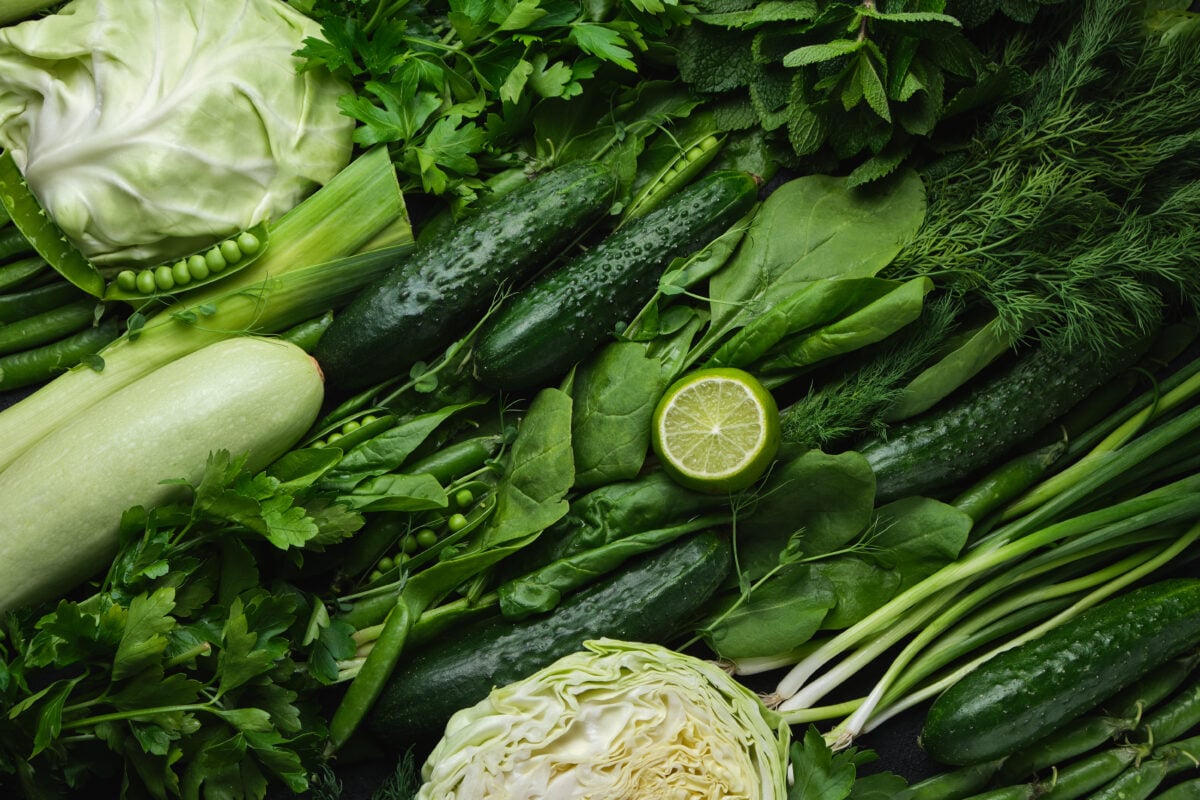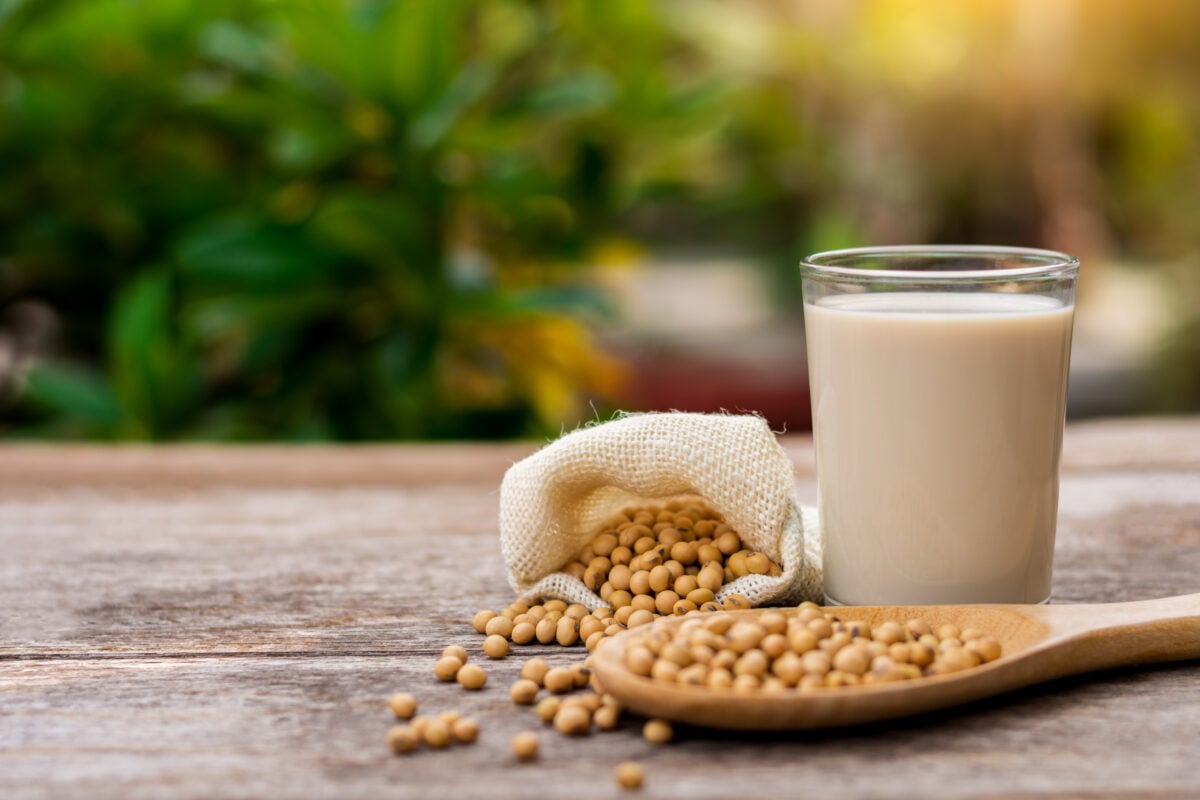Calcium is the most plentiful mineral in the human body, which makes it one of the most important nutrients for good health. Here’s everything you need to know about this essential chemical element, including which plant-based foods and ingredients to find it in.
Read more: USDA Urged To Remove Dairy Category From 2025 Dietary Guidelines
Why does the human body need calcium?
“Calcium is an essential mineral vital in various bodily functions,” Karine Stephan, registered nutritional therapy and lifestyle medicine practitioner and founder of Happy Living Nutrition, tells Plant Based News (PBN). “It is a critical component of bones and teeth, providing strength and structure to the skeletal system.”
Healthy adult humans contain between 1.2 and 1.4kg of calcium. Up to 99 percent of the body’s calcium is stored in the bones and teeth, but it also contributes to effective muscle movement and supports the heart, brain, nerves, blood pressure, clotting, and more.
According to the Mayo Clinic, some research indicates that the combination of calcium and vitamin D together may also protect against diabetes, high blood pressure, and cancer.
While calcium consumption is usually associated with dairy, it’s a myth that you need to consume milk or cheese to get it. Many plant-based foods are also rich in the essential mineral. Regardless of lifestyle, it’s important to ensure you’re consuming – and absorbing – enough calcium along with all other micro and macronutrients.
It is thought that around half of the world’s population has “inadequate access to dietary calcium.” While populations in low and middle-income countries are at the greatest risk of severe deficiency, many individuals in high-income countries also regularly fail to meet the recommended daily allowance (RDA) for calcium, including 42 percent of people in the US.
According to a pamphlet produced by the UK’s Whittington Health NHS Trust, calcium deficiency is unlike other nutrient shortages in that you may not know you’re lacking in something until you start experiencing serious negative health outcomes. For example, sometimes the first noticeable symptom is a fracture or the loss of a tooth.
How much calcium per day is recommended?

Calcium requirements vary greatly depending on a person’s age and sex, and according to the BBC, the RDA fluctuates throughout life along with other factors. Children aged 11 to 18 require from 800 to 1,000mg, while adults need slightly less at 700mg.
However, the National Institutes of Health (NIH) suggests that most people should be taking in more calcium than this. It lists an RDA of 1,300mg for children aged 9 to 18, and 1000 to 1,200mg for adults aged 19 and 70, with the higher amount for those assigned female at birth and over 50.
While being pregnant does not increase calcium needs, breastfeeding does require an additional 550mg on top of the typical adult RDA of 700mg, per the BBC.
After menopause, people should have up to 1,200mg of calcium per day, according to Johns Hopkins Medicine. The NIH notes that overall absorption decreases as humans age, and that taking in too much calcium (over 2000mg per day) actually reduces absorption rates.
Stephan adds that excessive salt and caffeine consumption can negatively impact the body’s absorption of calcium. It’s also important to note that optimal calcium absorption is partially dependent on vitamin D, which helps to regulate the amount of calcium and phosphate in the body. According to NIH, inadequate vitamin D can lower calcium absorption from 40 percent to as low as 10 percent.
When it comes to monitoring, Stephan notes that blood calcium levels may not always indicate a deficiency, but that markers like vitamin D can provide insight into bone health and calcium metabolism. If you are concerned about nutrient deficiencies for any reason, you should consult with your primary healthcare provider.
Read more: The 9 Healthiest Fruits, According To Nutritionists
11 best plant-based calcium sources
With the above in mind, here are some of the best plant-based sources of bioavailable calcium. Some of the foods below also contain vitamin D – such as dark leafy greens and okra – which support calcium absorption.
Conversely, certain leafy greens are not included. Stephan explains that some plant-based foods contain compounds that inhibit calcium absorption, such as oxalates and phytates.
“While leafy green vegetables like spinach and Swiss chard are sources of calcium, the calcium in these foods is less bioavailable due to their high oxalate content,” continues Stephan. (Note: spinach and chard are definitely still nutritional powerhouses, they just shouldn’t be your go-to for extra calcium.)
“It’s possible to meet the recommended daily allowance (RDA) of calcium through a well-planned plant-based diet that includes a variety of foods like fortified non-dairy milk, tofu, almonds, white beans, and fortified cereals,” adds Stephan.
Kale
Dark green leafy vegetables generally contain a good amount of calcium, including collard, beet, mustard greens, and arugula, as well as cabbage, broccoli, chard, and other brassica. But kale, in particular, is one of the top three plant-based, bioaccessible calcium-rich foods of all time according to a study published in ScienceDirect.
According to the ScienceDirect study, kale contains five times more bioaccessible calcium than a single serving of skimmed milk. It’s also rich in iron and vitamins C, K, E, A, and B6, along with magnesium, zinc, phosphorus, potassium, fiber, and antioxidants.
“As mentioned, oxalates are naturally occurring compounds in some plant foods that can bind to calcium and decrease absorption. Instead, focus on kale, broccoli, bok choy, and collard greens, which are lower in oxalates but still provide good calcium,” adds Stephan.
Finger millet
Another one of the top three plant-based sources of calcium in the ScienceDirect study is finger millet, or ragi. Where other millets have a shiny outer husk, finger millet grows as a naked grain without this outer protection. Finger millet is notably and consistently high in bioavailable calcium along with other important micronutrients like zinc and magnesium.
Finger millet is widely used across the Indian subcontinent for staple dishes such as paratha, dosas, and rotis, and it can be incorporated into pancakes and breads of all kinds. It also contains protein, fiber, and carbohydrates, but at 344mg per 100g, its most notable feature is its calcium content, which is higher than in all other cereals.
Fortified bread
Fortified bread was the third-best source of bioavailable calcium found by the ScienceDirect study, which the authors note indicates how impactful widespread calcium fortification could be in combating nutrient deficiencies worldwide.
Breakfast cereals are another one of the most common fortified foods, and studies indicate that regular consumption can also help “enhance calcium absorption.” Pairing fortified bread or cereal with fortified milk can make breakfast a particularly calcium-rich first meal.
Plant milks

While most plant milks are fortified with vitamins and minerals, soy milk is generally thought to be the most nutritious. According to Medical News Today, calcium-fortified soy milk contains approximately the same amount of calcium per cup as traditional dairy milk. Many varieties are also fortified with vitamin D, and soy milk contains less saturated fat than dairy.
Tofu
The calcium content of tofu can vary quite widely depending on the firmness, setting method, and brand, but opting for calcium-set (meaning calcium chloride or sulfate has been added) and as firm as possible is a practical way of maximizing your intake.
Calcium-set tofu can contain up to 350 mg of calcium per serving, while more traditional recipes contain just under 200mg. Cauldron-branded tofu, for example, contains up to 400mg per 100g serving, which is significantly higher than average. Stephan tells PBN that she typically opts for calcium-set tofu for this very reason.
Tofu is also high in protein and notably contains all of the essential amino acids that the body needs along with manganese, copper, selenium, vitamin A, phosphorus, zinc, magnesium, and iron, along with beneficial polyunsaturated fat.
Nuts and seeds
Nuts and seeds are also a good source of calcium, though some varieties – such as almonds – have quite a high fat-to-calcium and protein ratio. That said, a 30g serving of almonds contains 13 grams of “good” unsaturated fats and just one of saturated. It also contains 80 mg of calcium, about 13 percent of the RDA, along with iron, magnesium, and fiber.
Sunflower seeds, pistachios, sesame seeds, and chia seeds are all also fair sources of calcium. A 100g portion of chia contains around 631mg of calcium, around half of the RDA for adults. Meanwhile, 100g of sesame seeds contain up to 975mg.
“It’s also worth noting that soaking or sprouting beans, nuts, and seeds can help reduce phytates and improve calcium bioavailability,” says Stephan.
Beans
According to the ScienceDirect study on plant-based calcium, black and white chickpeas, kidney beans, and peas can all be considered “moderate” sources, where 1.5 to 3 servings is equivalent to a single serving of skimmed milk.
Medical News Today also highlights white beans, such as cannellini or lima, as being good sources of calcium. Edamame, or vegetable-type soybeans, contain up to 63 mg of calcium per 100g serving, while legumes like lentils contain around 19mg per 100g.
“I make hummus with white beans and add them to soups and stews,” says Stephan. “White beans, especially those properly soaked, such as cannellini beans, are rich in calcium. I try to have them with dark mushrooms to enhance calcium absorption. Indeed, mushrooms like shiitake and portobello mushrooms are sources of vitamin D.”
Okra
Okra, or “lady’s fingers,” contains around 88mg of calcium per portion, along with iron, magnesium, phosphorus, potassium, zinc, copper, selenium, and more. According to the Cleveland Clinic, a half-cup of cooked okra contains about six percent of the calcium RDA.
Dried fruit
Despite being super-sweet, dried fruits are still super-nutritious, with dates, apricots, and figs all containing calcium. Figs boast up to 162mg per portion, along with iron, magnesium, potassium, zinc, copper, manganese, and more.
Stephan previously told PBN that she eats a fig or two every day.
“Figs are incredibly versatile,” explained Stephan at the time. “I enjoy them in salads or as a dessert. They are also high in fiber and bone-friendly minerals. Eating fruits in season is a great way to diversify our diet and ensure that we are consuming fruits that are at their freshest and most nutritious, while also reaping environmental benefits.”
Sweet potatoes
A single large sweet potato contains around 68mg of calcium as well as potassium and vitamins C and A. Sweet potatoes are also extremely versatile, meaning that they can be incorporated into countless recipes – both sweet and savory.
Oranges
While oranges are best known for their high vitamin C content, the fruit also contains up to 40mg of calcium per 100g, or 70mg per portion. That means eating a single orange gives you up to six percent of your RDA of calcium along with about 80mg of vitamin C.
As with all of the foods listed above, the secret to meeting your quota for both macro and micronutrients is a varied and well-balanced diet. Combining calcium-rich foods like fortified milk, vegetables, cereal, seeds, and fruit into a single meal can seriously boost your intake.
“Variety is key. I recommend including various calcium-rich plant foods in your diet to help meet daily calcium requirements and maximize absorption,” concludes Stephan.
Read more: What Is Spirulina? The Protein-Packed Plant You Should Get To Know






